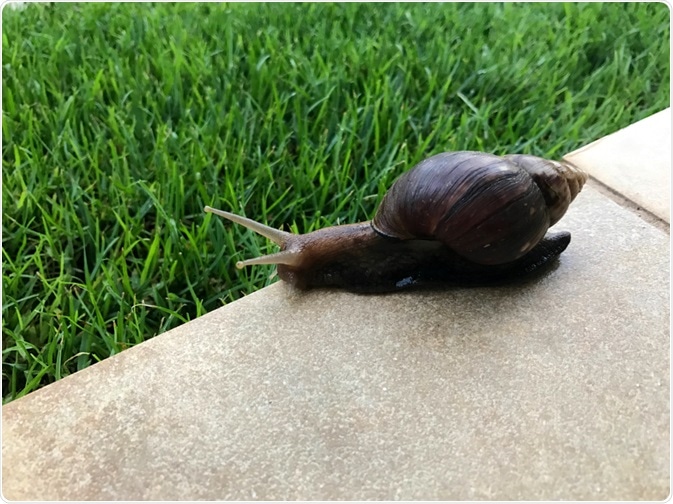Rat lungworm disease (RLWD), or angiostrongyliasis, is caused by Angiostrongylus cantonensis (A. cantonenis), a roundworm parasite that affects the central nervous system. The Hawaii Department of Health conducted a 50-month study on rat lungworm disease from January 2001 to February 2005.
 Image Credit: Meadow Todd/Shutterstock.com
Image Credit: Meadow Todd/Shutterstock.com
The number of eosinophilic meningitis cases reported was 84, of which 24 cases (29%) were due to rat lungworm disease. The number of incidences statewide in Hawaii was 42 (100%) during 2007–2015 and 38 belonged to Hawaii Island, contributing to 91% of incidences.
Causes and symptoms
The larval stage of the nematode A. cantonensis is said to be the cause of rat lungworm disease, with invasive snails and slugs, prawns, frogs, and rodents acting as vectors. Freshwater opihi, rats, and mice are the main hosts, however, other mammals also can be hosts. Studies confirm that Norway rats, black rats, and Polynesian rats are carriers and not house mice.
Humans are infected when they consume raw or undercooked vectors, food that is not cleaned, or when consuming fecal-contaminated food and water. After 1–3 weeks of infection, symptoms begin and show their presence from 2 to 8 weeks. In chronic cases, nerve damage also occurs and the condition can remain for months or even years. Nausea, vomiting, neck stiffness, severe headaches, and abnormal tingling are some of the symptoms that result in eosinophilic meningitis, dysfunction in the nervous system, and even death.
Outbreak in Hawaii
As per the research done in Hawaii, the parasite has infected more than 75% of semi-slugs collected from Big Island.
In Hawaii, the Cuban slug, Veronicella cubensis, the giant African snail, Achatina fulica, and the marsh slug, Deroceras, are considered to be the major intermediary hosts of A. cantonensis. The eastern Hawaii islands have a favorable environment for slugs, snails, and flatworms.
In 2004, a species of semi-slugs was discovered in the Hawaii islands and identified as Parmarion martensi, a polyphagous semi-slug that can grow well in a moisture-rich place like Hawaii.
Research in 2005 revealed that it was primarily seen in the Puna region (lower elevations) and in Kailua-Kona (western Hawaii). A common species in the eastern Hawaii islands, it was used as pest control for lettuce, papaya plantations, and in-home gardens.
A survey conducted in Hawaii has revealed the presence of this semi-slug on green plants such as lettuce, banana, and fallen fruit such as avocado and guava, and under plastic materials such as plant pots and catchment tanks. Even when the infested plants or parts of plants are removed, semi-slugs have the ability to travel long distances.
The semi-slug has a tendency to climb on structures, such as pipes, water tanks, and walls, and leave fecal deposits during its movement. It has been spotted near food preparation and sink areas and feeds on food kept for dogs or cats or food that was spilled.
The parasite can produce egg masses in large numbers. Upon testing, the eggs revealed the presence of A. cantonensis in a high percentage, increasing the probability to spread the disease.
In the Puna district of Hawaii, the water collected from rooftops is used for household purposes such as cleaning food, vegetables, and fruits. Due to this, consuming uncooked food and contaminated water is a potential source of A. cantonensis.
In the Hawaii islands, individuals are reported to be infected even twice or thrice, implying a lack of stable immunity.
Diagnosis and treatment
Both diagnosing and treating the disease is difficult. A spinal tap is done and the cerebrospinal fluid (CSF) is observed to analyze the presence of eosinophils. The organism does not stay in the extrameningeal space as it sticks to the meninges and moves to the neural tissue.
Blood samples are tested to check for the presence of antigens against the parasites.
The state laboratories in Hawaii diagnose the cases using polymerase chain reaction (PCR) tests that determine the presence of A. cantonensis DNA in the CSF or other tissues of the patients. The specimens of the patients are sent to the state laboratories division for PCR tests.
Physicians also check with patients about their travel history where the parasite is said to exist, check the consumption of raw snails or slugs that are suspected to carry A.cantonensis, and symptoms that show signs of rat lungworm disease in comparison with the laboratory findings in CSF. The symptoms can be reduced or relieved by the use of medicines.
To diagnose eosinophilic meningitis caused by A. cantonensis DNA, a TaqMan assay is also used. Serologic tests are available, however, the results are not reliable as they vary across laboratories. Diagnosis is done in combination with the Nucleic acid amplification test (NAAT).
What is Rat Lungworm (Angiostrongylus) Disease?
Safety measures
Prevention is the key. It is advised to:
- Avoid consuming raw snails or slugs
- Use gloves while gardening or handling snails or slugs and wash hands thoroughly thereafter
- Wash fruits, vegetables, and fresh produce
- Supervise children who may find snails or slugs to prevent them from eating them
- Boil food for 3–5 minutes or freeze at 5°F (15°C) for a minimum of 24 hours
References
Further Reading
Last Updated: Dec 21, 2022